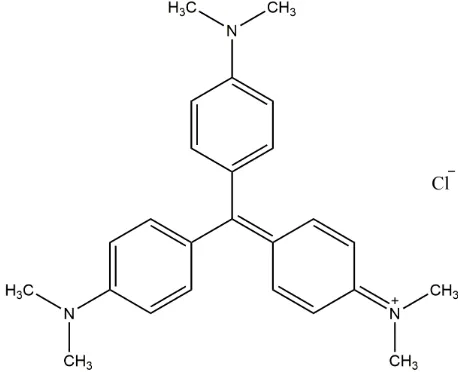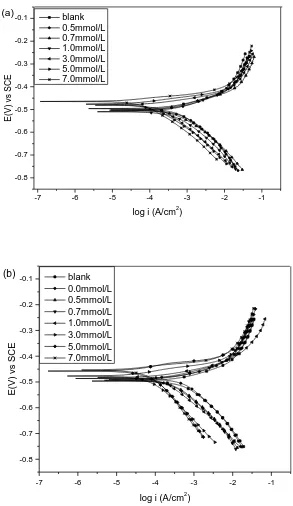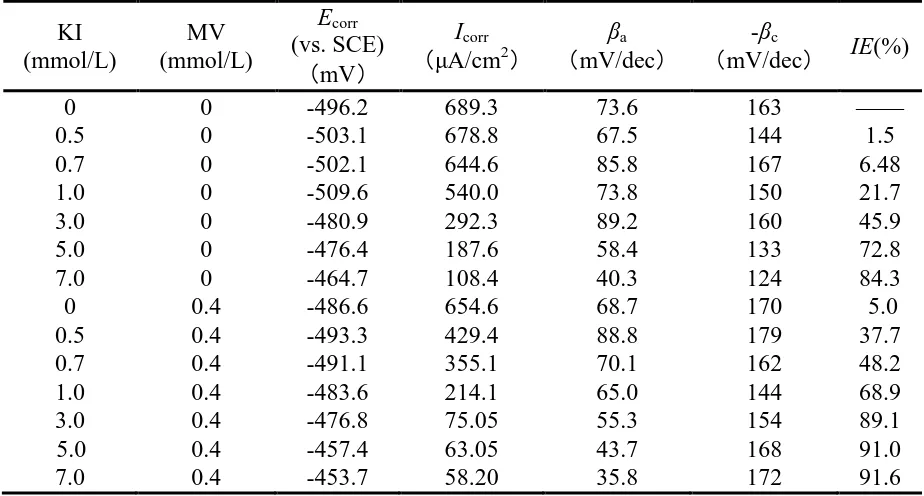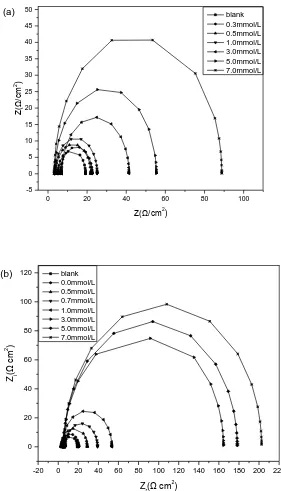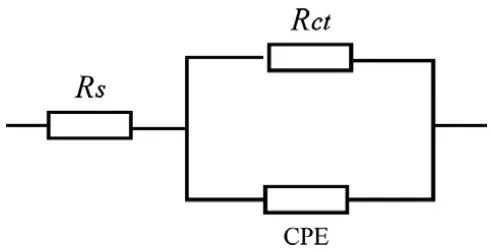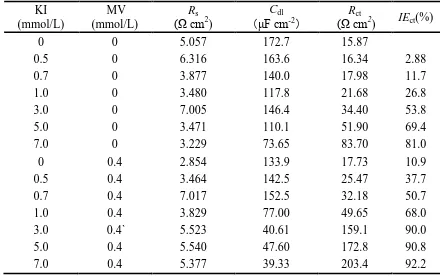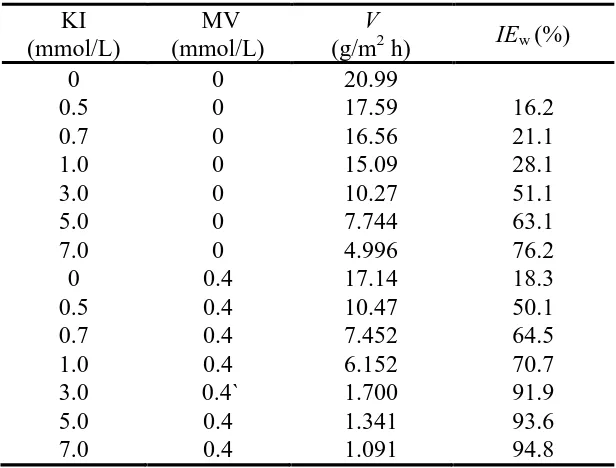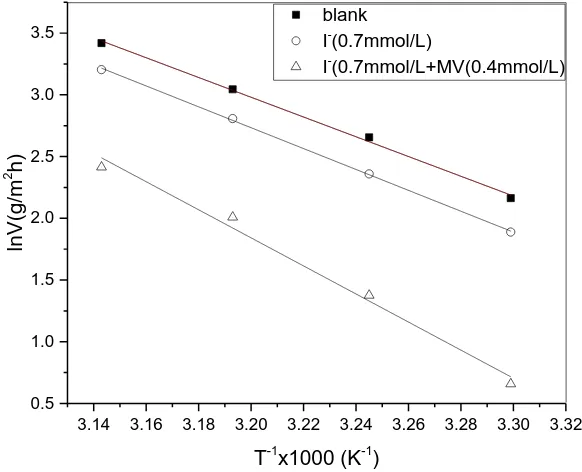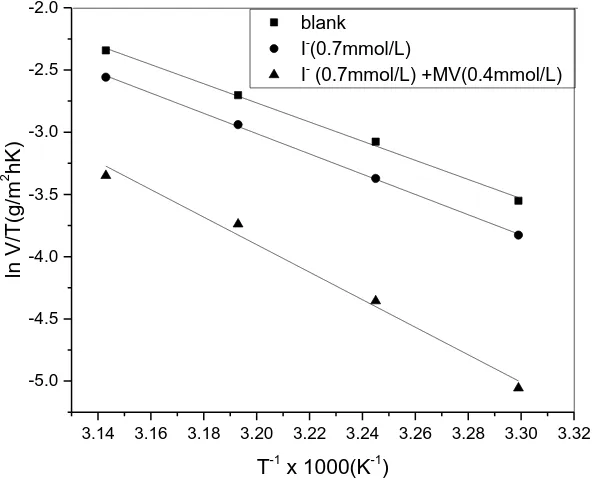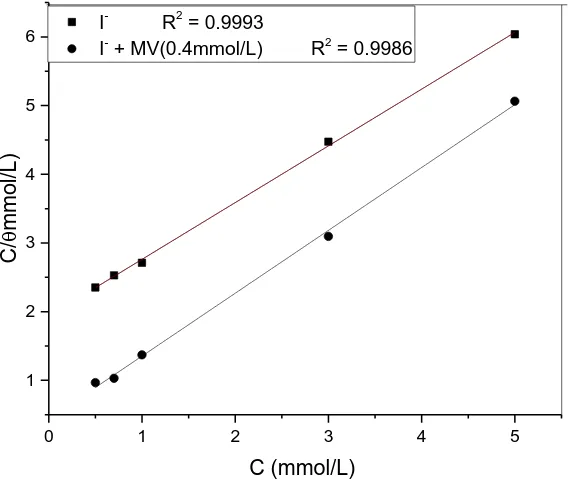Int. J. Electrochem. Sci., 13 (2018) 10718 – 10732, doi: 10.20964/2018.11.28
International Journal of
ELECTROCHEMICAL
SCIENCE
www.electrochemsci.orgSynergistic Effect of Iodide Ion and Methyl Violet on the
Corrosion Inhibition of Carbon Steel in Phosphoric Acid
Hui Liu, Yan-Ju Yang, Lin Wang*, Si-Min Ma, Xiao-Yan Peng, Dong-Mei Lu*, Teng Zhao, Zhong Wang
School of Chemical Science and Technology, Key Laboratory of Medicinal Chemistry for Nature Resource, Ministry of Education, Yunnan University, Kunming, Yunnan, 650091, P. R. China
*
E-mail: wanglin@ynu.edu.cn (LinWang); wanglin2812@163.com
Received: 18 June 2018 / Accepted: 22 August 2018 / Published: 1 October 2018
The corrosion inhibition effects of iodide ion and its synergistic effect with methyl violet (MV) on carbon steel in 1.0 mol/L phosphoric acid solution have been investigated using potentiodynamic polarization, electrochemical impedance spectroscopy and weight loss measurements. The results show that there is an excellent synergistic effect between iodide ion and MV for carbon steel corrosion inhibition in 1.0 mol/L H3PO4. The electrochemical studies reveal that single iodide ion or
combination of iodide ion and MV acts as a mixed-type inhibitor and the corrosion reaction is controlled by charge transfer process. Adsorption of iodide ion on the steel surface obeys Langmuir adsorption isotherm in the absence or presence of MV. The values of Kads, ΔGoads, ΔHa, ΔSa and Ea
were obtained and discussed. The adsorption of inhibitor molecules on the steel surface is a spontaneous process containing a mixed physical and chemical adsorption mechanism.
Keywords: Carbon steel, Corrosion, Phosphoric acid, Iodide ion, Methyl violet, Synergistic inhibition.
1. INTRODUCTION
It has been reported by Lagrenėe that nitrogen-containing organic compounds showed more effective inhibition in hydrochloric acid than in sulphuric acid for the steel corrosion[18]. The research indicated that there is a synergistic inhibition between nitrogen-containing compounds and chloride ions for steel corrosion in hydrochloric acid. Synergistic action is a useful way to enhance the inhibition ability of the inhibitor, to reduce the amount of usage and to extend the application of the inhibitor in acidic solution. Synergistic techniques have been frequently used in practice for its efficiency and economy [19-20]. Iodine and chlorine are the same main group elements. Compared with chloride ion, iodide ion (I-) should be adsorbed on the metal surface and provide better synergistic effect because iodide ion has larger radius and present the better polarizability and even bigger steric effect [19, 21-22].
Abdel Rehim et al have researched the synergistic inhibition effect of iodide ions and adenine on the corrosion of low carbon steel in sulphuric acid solution [23]. They have observed that the combination of adenine and I- improved the inhibition efficiency greatly because of synergistic effects. Musa et al have studied that the synergistic inhibition between pathalazone and I- for mild steel in hydrochloric acid solution [24]. They have found that the synergism of pathalazone and I- promoted improvement of inhibition efficiency significantly and observed that a cooperative mechanism exits between the iodide anion and pathalazone cations.
Methyl violet (MV) is an indicator and contains nitrogen atoms unshared electron pairs and abundant π-electrons aromatic rings. We have studied the inhibition of MV and chloride ion for the cold rolled steel corrosion in sulphuric acid solution [25]. The results indicated that MV and chloride ion show up a better synergistic inhibition effect for the steel corrosion. Phosphoric acid is a medium strong acid and shows strong aggressiveness for ferrous and ferrous alloys [26-27]. The metallic material equipment are vulnerable to corrosion attack in the wet process of phosphoric acid manufacture and the production of ammonium phosphate fertilizer. The aim of the present work is to research the synergism of MV and I- for carbon steel corrosion inhibition in phosphoric acid solution using potentiodynamic polarization, electrochemical impedance spectroscope (EIS) and weight loss measurements. We look forward to some useful results to guide the composing of inhibitors for phosphoric acid system.
2. EXPERIMENTAL
2.1. Materials
The carbon steel specimens have a chemical composition of (wt%): 0.18% C, 0.016% S, 0.021% P, 0.053% Si, 0.38% Mn and Fe balance.
Bidistilled water was used to prepare the experimental solutions and AR grade H3PO4 and
Figure 1. Structure of MV
2.2. Electrochemical measurements
The electrochemical measurements were conducted in a conventional three-electrode cell. The auxiliary electrode and reference electrode were a platinum foil and saturate calomel electrode (SCE), respectively. The working electrodes were embedded in PVC holder using epoxy resin with an exposed area of 1.0 cm2. Each working electrode was polished using emery papers (300 - 1200 grade) on the test face, washed with distilled water, degreased with acetone, and dried with a warm air stream. Before each measurement, the working electrode was immersed for two hours in the 250 ml experimental solution at open circuit potential until corrosion potential reached a steady state.
All the electrochemical experiments were performed using PARSTAT 2263 Potentiostat/Galvanostat (Princeton Applied Research). The potentiodynamic polarization curves were gained by changing the electrode potential from -250mV to + 250mV versus the open circuit potential, at a scanning rate of 0.5 mVs-1. EIS experiments were performed in the frequency range of 100 kHz to 10 mHz using a 10 mV peak to peak voltage excitation. Each experiment was performed in triplicate to ensure reproducibility.
2.3. Weight loss measurements
The specimens (40 mm × 15 mm × 0.4 mm) were successively polished with emery papers (300 - 1200 grade), washed in distilled water, degreased in acetone and dried in a stream of air.
3. RESULTS AND DISCUSSION
3.1. Polarization measurements
The polarization curves for carbon steel in 1.0 mol/L H3PO4 solution in the absence (a) and
presence (b) of 0.4 mmol/L MV at 40℃ are shown in Figure 2.
-7 -6 -5 -4 -3 -2 -1
-0.8 -0.7 -0.6 -0.5 -0.4 -0.3 -0.2 -0.1
E(V)
vs
SC
E
log i (A/cm2) blank
0.5mmol/L 0.7mmol/L 1.0mmol/L 3.0mmol/L 5.0mmol/L 7.0mmol/L (a)
-7 -6 -5 -4 -3 -2 -1
-0.8 -0.7 -0.6 -0.5 -0.4 -0.3 -0.2 -0.1
E(V)
vs
SC
E
log i (A/cm2) blank
[image:4.596.147.440.184.690.2]0.0mmol/L 0.5mmol/L 0.7mmol/L 1.0mmol/L 3.0mmol/L 5.0mmol/L 7.0mmol/L (b)
From Figure 2 (a), It can be seen that the presence of increasing amounts of I- caused a decrease in both anodic and cathodic current densities, but cathodic polarization was dominant. The presence of single I- slightly shifted the corrosion potential to both negative and positive directions. These showed that I- could retard the hydrogen evolution reaction and reduce anodic dissolution, which means that I- is a mixed-type inhibitor. By Figure 2 (b), with addition of 0.4 mmol/L MV, the Ecorr were slightly shifted to positive and the changes of anodic and cathodic branches were
approximate with those without MV, but it is clear that the shifting levels of cathodic and anodic are obviously larger. These results indicated that the combination of MV and I- is also a mixed-type inhibitor for carbon steel corrosion in H3PO4.
The inhibition efficiency (IE) could be calculated from the following formula:
0 100
0
coor inh coor coor
I I I
IE (1)
where I0corr and Iinhcorr are the corrosion current density values without and with inhibitors,
respectively.
The electrochemical polarization parameters: anodic and cathodic Tafel slopes (βa, βc),
corrosion current density (Icorr), corrosion potential (Ecorr), and the inhibition efficiencies for the carbon
steel corrosion in 1.0 mol/L H3PO4 are illustrated in Table 1. As seen, the change of Tafel slopes
showed no regularity with the change of I- concentrations, which means that the reactions of anodic metal dissolution and cathodic hydrogen evolution were both inhibited by the inhibitors through merely blocking the reaction active centers of steel surface without influencing the anodic and cathodic reaction mechanism [28-29].
Table 1. Electrochemical polarization parameters obtained for carbon steel in 1.0 mol/L H3PO4
containing different concentrations of I- without and with 0.4 mmol/L MV at 40 oC.
KI (mmol/L)
MV (mmol/L)
Ecorr
(vs. SCE)
(mV)
Icorr
(μA/cm2)
βa
(mV/dec)
-βc
(mV/dec) IE(%)
0 0 -496.2 689.3 73.6 163 ——
0.5 0 -503.1 678.8 67.5 144 1.5
0.7 0 -502.1 644.6 85.8 167 6.48
1.0 0 -509.6 540.0 73.8 150 21.7
3.0 0 -480.9 292.3 89.2 160 45.9
5.0 0 -476.4 187.6 58.4 133 72.8
7.0 0 -464.7 108.4 40.3 124 84.3
0 0.4 -486.6 654.6 68.7 170 5.0
0.5 0.4 -493.3 429.4 88.8 179 37.7
0.7 0.4 -491.1 355.1 70.1 162 48.2
1.0 0.4 -483.6 214.1 65.0 144 68.9
3.0 0.4 -476.8 75.05 55.3 154 89.1
5.0 0.4 -457.4 63.05 43.7 168 91.0
[image:5.596.48.510.488.736.2]
Compared with the values of Icorr and IE only in the presence of I- or MV, decreases of Icorr and
improvements of IE could be observed clearly in the co-existence of I- and MV, which means that combination of MV and I- is effective corrosion inhibitor for the carbon steel in H3PO4 solution. For
instance, the IE of the combination of MV and I- reached 91% at 5 mmol/L I- and 0.4 mmol/L MV.
3.2. Electrochemical impedance spectroscopy
0 20 40 60 80 100
-5 0 5 10 15 20 25 30 35 40 45 50
Z
(Ω/cm
2 )
Z(Ω/cm2
)
blank 0.3mmol/L 0.5mmol/L 1.0mmol/L 3.0mmol/L 5.0mmol/L 7.0mmol/L
(a)
-20 0 20 40 60 80 100 120 140 160 180 200 220
0 20 40 60 80 100 120
Zi
(Ω cm
2 )
Z
r(Ω cm 2
) blank
0.0mmol/L 0.5mmol/L 0.7mmol/L 1.0mmol/L 3.0mmol/L 5.0mmol/L 7.0mmol/L
(b)
[image:6.596.153.434.217.708.2]
The Nyquist plots for carbon steel in the absence and presence of different concentrations of I -alone (a) and in combination with 0.4 mmol/L MV (b) in 1.0 mol/L H3PO4 at 40oC are given in Figure
3.
From figure 3, a single depressed capacitive loop could been observed in the absence and presence of inhibitors in H3PO4, which shows that the charge transfer is the main controlling factor for
corrosion reaction process. The result indicates that the corrosion inhibition of carbon steel was affected mainly by charge-transfer process and the inhibitor did not change the mechanism of carbon steel dissolution [30]. The imperfect semicircles of capacitive loops are related to the frequency dispersion effect because of the roughness and inhomogeneous of the electrode surface [31]. Comparing the semicircles in the absence of MVwith those in the presence of MV, the diameters of the capacitance loops are clearly larger with MV than without MV, indicating that the presence of MV could improve inhibition performance of I- effectively. The impedance spectra for different Nyquist plots were analyzed on the basis of an equivalent circuit model which is well-known Randle cell, which includes a constant phase element (CPE), charge transfer resistance (Rct) and solution resistance
(Rs), given in figure 4. The value of double layer capacitance (Cdl) influenced by the surface
imperfections is simulated via CPE [32].
[image:7.596.177.423.369.495.2]
Figure 4. Equivalent circuit model used to fit the EIS experiment data.
The CPE is composed of a component Qdl and a coefficient b which quantifies different
physical phenomena such as surface inhomogeneous, porous layer formation, inhibitor adsorption, etc. The Cdl could be obtained from the formula [18]:
Cdl = Qdl·(2πfmax) b-1 (2)
where fmax represents the frequency at which the imaginary component of the impedance is
maximal on the Nyquist plot.
The inhibition efficiency (IEct) could be determined according to the relation:
100
) (
) 0 ( )
(
inh ct
ct inh ct ct
R R R
IE (3)
where Rct(inh) and Rct(0) are the charge-transfer resistances in the presence and absence
of inhibitor, respectively. Table 2 illustrates the values of Rs, Cdl, Rct, and IEct.
According to Table 2, the values of Cdl is decrease in the presence of inhibitors compare to the
adherent film and increased the thickness of the electrical double layer, which could be reason of decrease in Cdl [33-35]. Furthermore, the values of Rct and IEct both increase with increasing I
-concentration in the presence or absence of MV. However, the increase of Rct or IEct is clearly larger in
the presence of MV than in the absence of MV. These results have a good consistency with those obtained from polarization methods.
Table 2. Electrochemical impedance parameters obtained for the carbon steel in 1.0 mol/L H3PO4
containing different concentrations of I- without and with 0.4 mmol/L MV at 40 oC. KI
(mmol/L)
MV (mmol/L)
Rs
(Ω cm2
)
Cdl
(μF cm-2)
Rct
(Ω cm2
) IEct(%)
0 0 5.057 172.7 15.87
0.5 0 6.316 163.6 16.34 2.88
0.7 0 3.877 140.0 17.98 11.7
1.0 0 3.480 117.8 21.68 26.8
3.0 0 7.005 146.4 34.40 53.8
5.0 0 3.471 110.1 51.90 69.4
7.0 0 3.229 73.65 83.70 81.0
0 0.4 2.854 133.9 17.73 10.9
0.5 0.4 3.464 142.5 25.47 37.7
0.7 0.4 7.017 152.5 32.18 50.7
1.0 0.4 3.829 77.00 49.65 68.0
3.0 0.4` 5.523 40.61 159.1 90.0
5.0 0.4 5.540 47.60 172.8 90.8
7.0 0.4 5.377 39.33 203.4 92.2
3.3. Weight loss measurements
The inhibition efficiency (IEw)by weight loss was calculated using following equation:
100
0 0
V V V
IE i
w (4)
where V0 and Vi are the corrosion rates in the absence and presence of the inhibitors,
respectively.
Table 3 illustrates the corrosion rates and inhibition efficiencies of carbon steel for alone I- and mixture of MV and I- in 1.0 mol/L H3PO4 at 40 oC.
[image:8.596.76.518.213.489.2]
Table 3. Corrosion rates and inhibition efficiencies obtained by weight loss for the carbon steel in 1.0 mol/L H3PO4 containing different concentrations of I- without and with 0.4 mmol/L MV at 40 o
C.
KI (mmol/L)
MV (mmol/L)
V
(g/m2 h) IEw (%)
0 0 20.99
0.5 0 17.59 16.2
0.7 0 16.56 21.1
1.0 0 15.09 28.1
3.0 0 10.27 51.1
5.0 0 7.744 63.1
7.0 0 4.996 76.2
0 0.4 17.14 18.3
0.5 0.4 10.47 50.1
0.7 0.4 7.452 64.5
1.0 0.4 6.152 70.7
3.0 0.4` 1.700 91.9
5.0 0.4 1.341 93.6
7.0 0.4 1.091 94.8
3.4. Effect of temperature
Temperature is an important parameter on the progress of metal dissolution in acid solution. The effects of different temperature (30-45 oC) on the corrosion rate of carbon steel in the 0.7 mmol/L I- with and without 0.4 mmol/L MV in 1.0 mol/L H3PO4 solution were researched by weight loss
method. The results are illustrated in Table 4.
Table 4. The effect of temperature on the corrosion of carbon steel in the absence and presence of 0.7 mmol/L KI without and with 0.4 mmol/L MV in 1.0 mol/L H3PO4.
T (oC)
blank V(g/m2h)
I- IEw
V(g/m2h) (%)
I-+MV V(g/m2h)
IEw
(%) 30 8.701 6.590 24.3 1.932 77.8
35 14.22 10.77 24.2 3.953 72.2
40 45
20.99 30.55
16.56 21.1 24.62 19.4
7.452 11.18
64.5 63.4
[image:9.596.85.515.539.627.2]
A RT
E
V a ln
ln (5)
where Ea is apparent activation energy, R is the gas constant, T is the absolute temperature and
A is pre-exponential factor. Figure 5 shows the Arrenius plots for carbon steel containing I- or I-+MV in 1.0 mol/L H3PO4. The Ea values could be calculated by the slopes of the Arrenius plots.
3.14 3.16 3.18 3.20 3.22 3.24 3.26 3.28 3.30 3.32 0.5
1.0 1.5 2.0 2.5 3.0
3.5 blank I
-(0.7mmol/L)
I-(0.7mmol/L+MV(0.4mmol/L)
lnV(g/
m
2 h)
[image:10.596.146.437.184.420.2]T-1x1000 (K-1)
Figure 5. Arrhenius plots of the carbon steel in 1.0 mol/L H3PO4.
The enthalpy of activation (ΔHa) and entropy of activation (ΔSa) for the corrosion of carbon
steel were calculated by the transition state equation [37]:
exp(
)
exp(
)
RT
H
R
S
Nh
RT
V
a
a(6)
Where N is Avogadro’s number and h is Plank’s constant. Equation (6) can be rearranged to another kind of expression form in order to carry simple calculation:
RT H R
S Nh
R T
V a a
ln( ) )
ln( (7)
A straight line with the slope (-ΔHa/R) and intercept [ln (R/Nh) + ( ΔSa/R)] can be given from a
plot of ln (V/T) against 1/T. The plots from equation (7) for carbon steel containing I- or I-+MV in 1.0 mol/L H3PO4 are shown in Figure 6.
The calculated values of Ea, ΔHa and ΔSa are tabulated in Table 5. It is noticed that the values
of ΔHa and Ea in the presence of inhibitor is greater than that in the absence of inhibitor, indicating that
inhibitor may be attributed to the physical adsorption mechanism of the inhibitor on the metal surface [38-39]
3.14 3.16 3.18 3.20 3.22 3.24 3.26 3.28 3.30 3.32 -5.0
-4.5 -4.0 -3.5 -3.0 -2.5 -2.0
blank I-(0.7mmol/L)
I- (0.7mmol/L) +MV(0.4mmol/L)
ln V/T
(g
/m
2 hK)
[image:11.596.143.439.133.373.2]T-1 x 1000(K-1)
Figure 6. Transition state plots of the carbon steel in 1.0 mol/L H3PO4.
Table 5. Activation parameters for the corrosion of carbon steel in 1.0 mol/L H3PO4 without and with
KI or KI + MV. I- (mmol/L)
MV (mmol/L)
Ea (kJ/mol)
△Ha (kJ/mol)
△Sa (J/mol)
0 0 66.63 63.94 -15.83
0.7 0 70.42 67.74 -5.746
0.7 0.4 94.66 91.95 64.31
The negative values of ΔSa in the absence of the inhibitor means that the activated complex
represents association rather than the dissociation step [40]. In the presence of I- or I- + MV, the values of ΔSa becomes less negative or more positive. The adsorption of inhibitor is accompanied by
desorption of water molecules from the steel surface and the increase of solvent entropy causes the increasing in entropy of activation [41]. The increase of entropy is the driving force for the adsorption of the inhibitor onto the carbon steel surface [42].
3.5. Adsorption isotherm
Adsorption isotherms are usually used to investigate the corrosion inhibition mechanism of the inhibitor molecules on the metal surface. It is assumed that the adsorption of I- or I- + MV on the surface of carbon steel follows the Langmuir
[image:11.596.108.488.460.535.2]
C
K C
ads
1
(8)
Where C is the concentration of the inhibitor, θ is the degree of surface coverage and Kads is the
adsorptive equilibrium constant. The θ was calculated using the following formula [43]:
m V V
V V
0 0
(9) where Vm is the smallest corrosion rate.
0 1 2 3 4 5
1 2 3 4 5
6 I
R2 = 0.9993
I- + MV(0.4mmol/L) R2 = 0.9986
C/
mmo
l/L)
[image:12.596.152.436.223.463.2]C (mmol/L)
Figure 7. The plot of C/ against C in 1.0 mol/L H3PO4 at 40℃.
Figure 7 shows the plot of C/θ against C in the different concentration of I-
with or without 0.4 mmol/L MV in 1.0 mol/L H3PO4 at 40℃ by weight loss measurements. The linear regression
cocefficient values of the plot are close to unity, indicating that the adsorption of I- with or without MV on the surface of carbon steel in 1.0 mol/L H3PO4 obeys Langmuir adsorption isotherm. The values of
Kads calculated are
0.5167×103(M-1) in the presence of I- alone and 2.288×103(M-1)in the presence of I- + MV, respectively. The value of Kads is greater in the presence of MV than the absence, showing that
the tendency of adsorption of mixture of MV and I- is more intense than single I- on the steel surface. The standard free energy of adsorption (ΔGoads) could be obtained from the formula [44-45]:
exp( ) 5
. 55
1
RT G
K ads
ads
(10)
where the value of 55.5 is the concentration of water in the solution in mole units. Normally, the values of ΔGo
ads up to -20 kJ/mol are associated with the electrostatic interactions (physisorption),
sharing or transferring from the inhibitor molecules to the metal surface to form a coordinate bond [46-47]. The calculated values of ΔGo
ads for I- without and with 0.4 mmol/L MV are 26.75 kJ/mol and
-30.36 kJ/mol, respectively. These ΔGo
ads values obtained suggest that the adsorption process of I- on
the carbon steel without and with MV in 1.0 mol/L H3PO4 may involve both physisorption and
chemisorption and the physisorption is dominant in the presence of I- alone. The results of ΔGoads
values and decrease of inhibition efficiency with increasing temperature indicate that the adsorption of the inhibitor on the carbon steel surface in H3PO4 is unfavorable at higher temperature and hence can
be regarded as predominantly physical adsorption.
3.6. Synergism effect
The above studies indicate that the inhibition efficiencies for solution in the presence of MV exhibit higher values in comparison with solution in the absence of MV. This means that there may be a synergistic inhibition effect of I- and MV on corrosion process of carbon steel in 1.0 mol/L H3PO4,
which can be described from synergism parameters (S), obtained as follows [30]:
1 2
1 2
1 ( ) 1
IE IE S
IE
(11)
where IE1 and IE2 are the inhibition efficiencies in the presence of inhibitor 1 or inhibitor 2
alone, respectively. IE1+2 is the inhibition efficiency for combination of inhibitor 1 and inhibitor 2.
[image:13.596.126.472.536.669.2]Generally, value of S > 1 indicates a synergistic effect and value of S < 1 implies antagonistic behavior leading to competitive adsorption prevails [22, 48]. The calculated values of S from three experimental methods are listed in Table 6. It is clear that all of S values are greater than unity and behave larger, which clearly shows that there is a stronger synergistic inhibition effect between I- and MV for carbon steel corrosion in 1.0 mol/L H3PO4, leading to inhibition efficiency improved greatly. Table 6. Synergism parameters of I- with 0.4 mmol/L MV for the carbon steel corrosion inhibition in
1.0 mol/L H3PO4 at 40℃ from the three methods.
KI (mmol/L)
Synergism parameters(S)
polarization EIS weight loss 0.5 1.50 1.38 1.31
0.7 1.72 1.57 1.71
1.0 2.36 1.95 1.83
3.0 4.51 3.53 3.78
5.0 2.46 2.14 2.91
7.0 1.27 1.03 1.09
In acid solution, steel surface contains positive charge due to Ecorr – Eq = 0 (zero charge
H3PO4. With addition of MV, the positively charged MV can also be easily approach the steel surface
and the MV molecules can also be adsorbed through donor-acceptor interactions between the abundance π-electrons or nitrogen atom of MV and the unoccupied d-orbital of the iron atoms. So, chemisorption and physisorption could be combined action on the carbon steel surface.
4. CONCLUSION
(1) Single I- or MV does not show desirable inhibition efficiency for carbon steel corrosion in 1.0 mol/L H3PO4. The addition of MV enhances the inhibition efficiency of I- obviously. The
synergism parameters indicate that there is a stronger synergistic inhibition effect between I- and MV for carbon steel corrosion in 1.0 mol/L H3PO4.
(2) The adsorption of I- on the surface of carbon steel obeys the Langmuir adsorption isotherm in the absence or presence of MV. The adsorption of inhibitor molecules is a spontaneous process containing combination of physical and chemical adsorption.
(3) Single I- or mixture of I- and MV retards the cathodic and anodic reaction for carbon steel corrosion in 1.0 mol/L H3PO4, however the cathodic polarization is dominant for the presence of I
-alone. I- and I-+ MV act as mixed type inhibitor and retard cathodic hydrogen evolution reaction and reduce anodic steel dissolution. EIS shows that the corrosion reaction is controlled by charge transfer.
The results obtained from polarization, EIS and weight loss measurements show good consistency.
ACKNOWLEDGEMENT
This work was financially supported by the National Innovation and Entrepreneurship of College Students Foundation of China (Grant No.201610673001).\
References
1. A.Y. El-Etre, Mater. Chem. Phys., 108 (2008) 218.
2. S. Papavinasam, A. Doiron, T. Panneerselvam and R.W. Revie, Corrosion, 63 (2007) 704. 3. S. Sathiyanarayanan, C. Jeyaorabha and G. Venkatachari, Mater. Chem. Phys., 107 (2008) 350. 4. Y. Abboud, A. Abourriche, T. Saffaj, M. Berrada, M. Charrouf, A. Bennamara, A. Cherqaoui and
D. Takky, Appl. Surf. Sci., 252 (2006) 8178.
5. L. Toukal, S. Keraghel, F. Benghanem and A. Ourari, Int. J. Electrochem. Sci., 13 (2018) 951. 6. G. Sığırcık, D. Yildirim and T. Tüken, Corros. Sci., 120 (2017) 184.
7. L. Wang, H. Zheng, X.M. Zi, S.W. Zhnag, L. Peng and J. Xiong, Int. J. Electrochem. Sci., 11 (2016) 6609.
8. L. Wang, Corros. Sci., 48 (2006) 608.
9. M.A. Bedair , M.M.B. El-Sabbah , A.S. Fouda and H.M. Elaryian, Corros. Sci., 128 (2017) 54. 10.M.J. Banera, J.A. Caram, C.A. Gervasi and M.V. Mirifico, J. Appl. Electrochem., 44 (2014) 1337. 11.R. Solmaz, G. Kardas, M. Çulhha, B. Yazici and M. Erbil, Electrochem. Acta, 53 (2008) 5941. 12.L. Wang, Corros. Sci., 43 (2001) 2281.
13.X. Guo, B. Hurley, F. Yang and R. Buchheit, Electrochimica Acta, 246 (2017) 197. 14.L.A. AI Juhaiman, Int. J. Electrochem. Sci., 11 (2016) 2247.
16.A. Dutta, S. Kr. Saha, U. Adhikari, P. Banerjee and D. Sukul, Corros. Sci., 123 (2017) 256. 17.C. Cardona, A.A. Torres, J.M. Miranda-Vidales, J.T. Pérez, M.M. González-Chávez, H.
Herrera-Hernández and L. Narváez, Int. J. Electrochem. Sci., 10 (2015) 1966.
18.M. Lagrenėe, B. Mernari, M. Bouanis, M. Traisnel and F. Bentiss, Corros. Sci., 44 (2002) 573. 19.R. Fuchs-Godec and M.G. Pavlović, Corros. Sci., 58 (2012) 192.
20.A. Khamis, M.M. Saleh and M.I. Awad, Corros. Sci., 66 (2013) 343. 21.G.K. Gomma, Mater. Chem. Phys., 55 (1998) 241.
22.S.A. Umeron, O. Ogbobe, I.O. Igwe and E.E. Ebenso, Corros. Sci., 50 (2008) 1998.
23.S.S Abdel Rehim, O.A. Hazzazi, M.A. Amin and K.F. Khaled, Corros. Sci., 50 (2008) 2258. 24.A.Y. Musa, A.B. Mohamad, A.A H. Kadhum, M.S. Takriff and L.T. Tien, Corros. Sci., 53 (2011)
3672.
25.L. Wang, F. Yang, J. Ma, Z. Fang, S. Zhang and Q. Guo, Asian J. Chem., 25 (2013) 10305. 26.P.B. Mathur and T. Vasudevan, Corrosion, 38 (1982) 171.
27.L. Wang, Corros. Sci., 43 (2001 ) 1637.
28.A.K. Satapathy, G. Gunasekaran, S.C. Sahoo, K. Amit and P.V. Rodrigues, Corros. Sci., 51 (2009) 2848.
29.K. C. Emeregül and M. Hayvalí, Corros. Sci., 48 (2006) 797.
30.L. Larabi, Y. Harek, M. Traisnel and A. Mansri, J. Appl. Electrochem., 34 (2004) 833.
31.M. Lebrini, M. Lagrenée, H. Vezin, M. Traisnel and F. Bentiss, Corros. Sci., 49 (2007) 2254.
32.P. Bommersbach, C. Alemany-Dumont, J. P. Millet and B. Normand, Electrochim. Acta, 51 (2006) 4011.
33.M. Behpour, S.M. Ghoreishi, M. Khayatkashani and N. Soltani, Corros. Sci., 53 (2011) 2489.
34.H. Ashassi-Sorkhabi and M. Eshaghi, Mater. Chem. Phys., 114 (2009) 267.
35.F. Bentiss, M. Lagrenée, M. Traisnel and J.C. Hornez, Corros. Sci., 41 (1999) 789. 36.E.E. Ebenso and I.B. Obot, Int. J. Electrochem. Sci. 5 (2010) 2012.
37.F. Bentiss, M. Lebrini and M. Lagrenée, Corros. Sci., 47 (2005) 2915. 38.T. Szauer and A. Brand, Electrochim. Acta, 26 (1981) 1253.
39.S.M.A. Hosseini, M. Salari, E. Jamalizadeh, S. Khezripoor and M. Seifi, Mater. Chem. Phys., 119 (2010) 100.
40.A.E. Stoyanova, E.I Sokolova and S.N. Raicheva, J. Corros. Sci,. 39 (1997) 1595.
41.E.E. Qguzie, V.O. Njoku, C.K. Enenebeaku, C.O. Akalezi and C. Obi, Corros. Sci., 50 (2008) 3480. 42.M.M. Saleh, Mater. Chem. Phys., 98 (2006) 519.
43.I. Sekine, Y. Hirakawa, Corrosion, 42 (1986) 272.
44.M. Lebrini, M. Lagrenee, M. Traisnel, L. Genembre, H. Vezin and F. Bentiss, Appl. Surf. Sci., 253 (2007) 9267.
45.E. Khamis, Corrosion, 46 (1990) 476.
46.E. Machnikova, K.H. Whitmire and N. Hackerman, Electrochim. Acta 53 (2008) 6024 47.P. Lowmunkhong, D. Ungthararak and P. Sutthivaiyakit, Corros. Sci., 52 (2010) 48.K. Aramaki, N. Hackerman. J. Electrochem. Soc., 116 (1969) 568.
49.A. Döner, E.A. Şuhin, G. Kardaş and O. Serindağ, Corros. Sci., 66 (2013) 278.
50.H. Ashassi-Sorkabi, N. Gahlebsaz-Jeddi, F. Hashemzadeh and H.jahani, Electrochim. Acta, 51 (2006) 3848.
